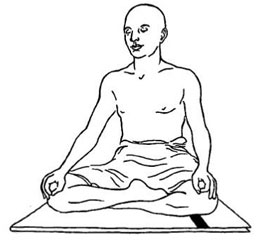There are four traditional schools of Yoga, and these are: Jnana Yoga, Bhakti Yoga, Karma Yoga, and Raja Yoga. While a Yogi or Yogini may focus exclusively on one of these approaches to Yoga, that is quite uncommon. For the vast majority of practitioners of Yoga, a blending of the four traditional types of Yoga is most appropriate. One follows his or her own predisposition in balancing these different forms of Yoga.
Jnana Yoga is the path of knowledge, wisdom, introspection and contemplation. It involves deep exploration of the nature our being by systematically exploring and setting aside false identities.
Jnana literally means 'knowledge', but in the context of yoga it means the process of meditative awareness which leads to illuminative wisdom. It is not a method by which we try to find rational answers to eternal questions, rather it is a part of meditation leading to self-enquiry and self-realisation.
Some of the components of Jnana Yoga are:
Karma Yoga is a system which develops immunity to the reactive and negative components of an action. This awareness of action leads to a greater ability to manage mental associations in the form of desires, ambitions, ego and other personality complexes.
The aim of Karma Yoga is to gain freedom from the bondage of karma which restricts and inhibits dynamic, creative and constructive expression in life. In the Bhagavad Gita Sri Krishna has emphasised the need for action as a means to become truly human and attain divine grace.
Karma Yoga is a sadhana and not a practice. The state of Karma Yoga can be attained through seva (selfless involvement in all activities), the spirit of which can be imbibed under the guidance of a competent master.
Some of the components of Karma Yoga are:
Raja Yoga usually refers to the system of yoga that is described in the Yoga Sutras of Sage Patanjali. In this ancient text Sage Patanjali describes eight stages of yoga which are known collectively as Raja Yoga.
Raja Yoga is a comprehensive yoga system which deals with the refinement of human behaviour and personality through the practice of the yamas (restraint) and niyamas (disciplines); attainment of physical health and vitality through asanas (postures) and pranayamas (pranic breathing techniques); management of mental and emotional conflicts and development of awareness and concentration through pratyahara (sensory withdrawal) and dharana (concentration); and developing the creative aspect of consciousness for transcendental awareness through dhyana (meditation) and samadhi (absorption in the universal identity).
Yamas - The Yamas or restraints (Don'ts) are divided into five moral injuctions, aimed at destroying the lower nature.
Niyamas - The Niyamas or observances (Do's) are also divided into five and complete the ethical precepts started with the Yama. These qualities are:
Bhakti Yoga is the path of devotion, emotion, love, compassion, and service to God and others. All actions are done in the context of remembering the Divine.
Bhakti Yoga is considered the easiest yogic path to master and the most direct method to experience the unity of mind, body and spirit. While Hatha Yoga requires a strong and flexible body, Raja Yoga requires a disciplined and concentrated mind, and Jnana Yoga requires a keen intellect, the only requirement for Bhakti Yoga is an open, loving heart. But Bhakti Yoga complements other paths of yoga well, and it is said that jnana (knowledge or wisdom) will dawn by itself when you engage in the devotional practices of Bhakti Yoga.
The Nine Limbs of Devotion
The term Hatha Yoga has been commonly used to describe the practice of asana (postures). The syllable ha denotes the pranic (vital) force governing the physical body and tha denotes the chitta (mental) force thus making Hatha Yoga a catalyst to an awakening of the two energies that govern our lives. More correctly the techniques described in Hatha Yoga harmonise and purify the body systems and focus the mind in preparation for more advanced chakra and kundalini practices.
The Hatha Yoga system includes asana along with the six shatkarmas (physical and mental detoxify techniques), mudras and bandhas (psycho-physiological energy release techniques) and pranic awakening practices. Fine tuning of the human personality at increasingly subtle levels leads to higher states of awareness and meditation.
Kriya yoga means 'the yoga of practice, movement or action'. Unlike the various religious, mystical or yogic practices which demand mental control, the special instruction in the system of kriya yoga is, 'Do not worry about the mind.' If your mind is dissipating or if there are distractions in your mind and you are not able to concentrate even for one second, it does not matter. You have only to continue with your practices, for even without confronting, controlling or trying to balance the mind, you can still evolve.
We should not consider the techniques of kriya yoga as practices of concentration or meditation as their aim is not mental control. The beauty of kriya yoga is that you have only to remain relaxed and let the mind move naturally and spontaneously. Inner awareness will then awaken, and in time, your mind will automatically become one-pointed.

Asana means a state of being in which one can remain physically and mentally steady, calm, quiet and comfortable. In the Yoga Sutras of Patanjali there is a concise definition of yogasanas: "Sthiram sukham aasanam", meaning that position which is comfortable and steady. Asanas are specific body positions which open the energy channels and psychic centres. They are tools to higher awareness and provide the stable foundation for our exploration of the body, breath, mind and beyond.